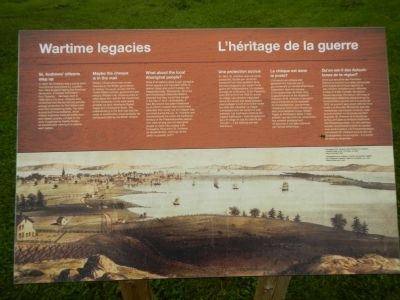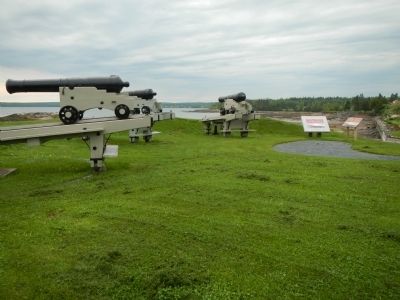St. Andrews in Charlotte County, New Brunswick — The Atlantic Provinces (North America)
Wartime legacies
L’heritage de la guerre

Photographed By Barry Swackhamer, June 10, 2014
1. Wartime legacies Marker
Caption: (on right) Lithograph of St. Andrews. After the sketch by Lieutenant Frederick Wells of the 1st Royals, ca. 1848; Lithographie de St. Andrews. D’après un esquisse realize par le lieutenant Frederic Wells de 1st Royals, vers 1848.
St. Andrews’ citizens step up
In 1812, St. Andrews was a young town, founded not long before by Loyalists from New England fleeing the American Revolution. A modest fortification - Fort Tipperary - had been built in 1808 above the town. Citizens were concerned that the fort did not provide enough protection for the harbour and river from privateering raids. The town quickly built three batteries, which military engineers believed ineffective - and indeed possibly a threat to the town if captured by hostile forces - so blockhouses were built to defend each battery.
Maybe the cheque is in the mail
Military infrastructure was usually financed by the British government or military. However, as war with the United States loomed, government and military officials in St. Andrews were at odds about the need for the investment, so the necessary funds were raised privately by local merchants Robert Pagan and Christopher Scott. The understanding at the time was that the cost of construction would probably be reimbursed by the British military.
What about the local Aboriginal people?
While First Nations allies fought alongside British regulars and Canadian Militia to defend Upper and Lower Canada, the Passamaquoddy, Penobscots, Mi’kmaq and Wolastoqiyik (Malecite) Nations declared that they would take no part in the War of 1812, Undoubtedly, if New Brunswick had been threatened by an enemy invasion, they would have defended their lands, but no invasion was launched during the war. St. Andrews and the blockhouse are within the traditional territory of the Passamaquoddy people who were among the first Aboriginal people to come into contact with Europeans. They know St. Andrews as Qonasqamkuk, meaning “at the sandy or gravelly point”.
French on right
Une protection accrue
En 1812, St. Andrews était une jeune collectivité, fondée peu de temps auparavant par des Loyalistes de la Nouvelle-Angleterre qui avaient fui la guerre de l’Independence. Un modeste ouvrage de fortification, le fort Tipperary, avait été construit en 1808 en amont du village. Les citoyens craignaient que le fort ne soit pas assez puissant pour protéger le port la rivière contre les raids des corsaires. Le village s’empressa donc de construire trois batteries. Les ingénieurs militaires les jugeant inefficaces - voire dangereuses pour le village en cas de capture par l’ennemi -, il les renforça par des blockhaus.
Le chèque est dan la poste?
L’infrastructure militaire était généralement financée par le gouvernement ou l’armée britannique. Cependant, face à la menace d’une guerre avec les États-Unis, le gouvernement et les dirigeants militaires de St. Andrews n’arrivaient pas à s’entendre sur la nécessite de l’investissement. Les sommes nécessaires furent donc réunies par deux commerçants locaux, Robert Page et Christopher Scott. Il était entendu que les couts des construction leur seraient probablement remboursés à une date ultérieure par l’armée britannique.
Qu’en est-il des Autochtones de la région?
Alors que des allies des Premieres Nations se battirent aux côtés des soldats britanniques de la force réguliers et dest miliciens canadiens pour défendre le Haut et le Bas-Canada. Les nations Passamquoddy, Penobscot, Mi’kmaq et Wolastqiyik (Malecite) déclarèrent qu’ils ne perdraient aucune part à la guerre de 1812. Ils auraient sans doute défendu leurs terres si le Nouveau-Brunswick avait été menace par une invasion ennemie, mais aucune invasion ne fut lancée pendant la guerre. St. Andrew et le blockhaus se trouvent dans le territoire traditionnel des Parramaquoddys, l’im des premiers peuples autochtones à entrer en contact avec les Européens. Lest Possamaquoiddys connaissent St. Andrews sous le nom de Qonasqamkuk, ce que signifie “à la pointe de sable ou le gravier”.
Erected by Parks Canada.
Topics. This historical marker is listed in these topic lists: Forts and Castles • Native Americans • War of 1812. A significant historical year for this entry is 1812.
Location. 45° 4.615′ N, 67° 3.73′ W. Marker is in St. Andrews, New Brunswick, in Charlotte County. Marker is on Joes Point Road close to Harriet Street, on the right when traveling east. Touch for map. Marker is at or near this postal address: 23 Joes Point Road, St Andrews NB E5B, Canada. Touch for directions.
Other nearby markers. At least 8 other markers are within walking distance of this marker. Welcome, Enjoy your visit! (here, next to this marker); Two hundred years and counting (a few steps from this marker); St. Andrews Blockhouse (within shouting distance of this marker); War of 1812: Defending St. Andrews (within shouting distance of this marker); Blockhouse 101 (within shouting distance of this marker); Greenock Church / L’Église Greenock (approx. 0.7 kilometers away); St. Croix River (approx. 0.8 kilometers away); Lest We Forget (approx. 0.8 kilometers away). Touch for a list and map of all markers in St. Andrews.
More about this marker. This marker is located near the battery.
Credits. This page was last revised on June 16, 2016. It was originally submitted on September 22, 2014, by Barry Swackhamer of Brentwood, California. This page has been viewed 375 times since then and 6 times this year. Photos: 1, 2. submitted on September 22, 2014, by Barry Swackhamer of Brentwood, California. • Andrew Ruppenstein was the editor who published this page.
